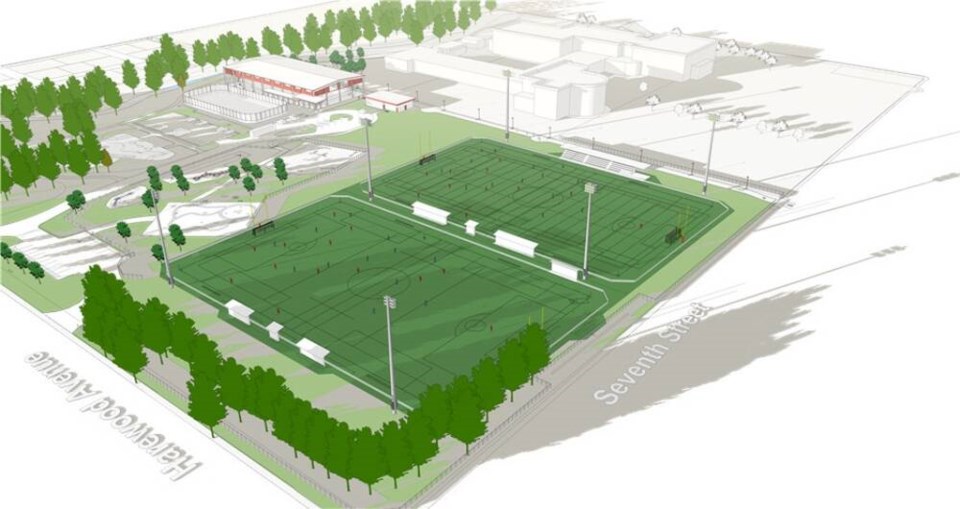When the cost of building twin artificial turf fields in Nanaimo doubled to $10 million, proponents feared it might kill or delay the project in Nanaimo’s south end after years of planning — and waiting lists to use sports fields in the city.
But this week, a majority of the city’s finance committee supported a staff recommendation on how to come up with money to pay for the massive overrun for the Harewood Centennial Park all-weather fields.
Recommendations from the finance committee, which consists of all members of council, go to council for final approval.
Health and environmental concerns around use of artificial turf, along with the higher cost, were raised by some councillors who voted against moving ahead immediately, but they were outvoted.
In recent months, costs for major projects have soared amid high inflation and supply-chain problems, hitting both public and private sector initiatives.
Coun. Hilary Eastmure said she was worried about the cost of artificial turf fields, but noted the city has access to the province’s Growing Communities Fund to help pay for it. “I think this is a perfect example of a place that we could put that money to really good use in a neighbourhood that really needs it at a school that deserves it.”
The park where the turf fields will go is adjacent to John Barsby Secondary School.
Coun. Janice Perrino also backed the project despite the “enormous” cost increase, citing the fields’ value to the community. “Anytime we can do recreational fields like this where people can get out, get in the sunshine and be together with teams is so important,” she said. “I could never say ‘no’ to this project.”
Perrino disagreed with a suggestion that the project be delayed in case prices drop next year, saying she expects they will continue to climb.
“I hate that costs have gone up. But you know, Harewood [neighbourhood] deserves this project to be done,” she said, echoing Eastmure. “We have to get going on this as quickly as possible. I don’t want to wait another year or two or three.”
Richard Harding, Nanaimo’s general manager of parks, recreation and culture, said the project was initially costed out prior to the pandemic. But as it became apparent that it would end up $2 million to $3 million higher than initially expected, council was informed.
Construction bids for the civil portion of the work, representing the bulk of project costs, came in last month at between $7.4 million and $9.6 million, reflecting the current state of the construction market.
“The tender prices exceeded expectations,” Harding said in a report, adding: “Things could change next year. They could go higher.”
The project needs to either be awarded now or cancelled and re-examined another year, he said, adding not going ahead would put the city behind in providing “much needed and used sports facilities.”
The extra cost of the fields is expected to be funded with $3 million from the province’s Growing Communities Fund, almost $1.5 million from the city’s strategic infrastructure reserve fund, $330,000 from its casino reserve fund, and an extra $200,000 from School District 68.
School board chair Greg Keller said in a letter that the board decided to add $200,000 to its previous $500,000 contribution “with the firm belief that it will provide tremendous benefits to our students and the wider community.”
Coun. Ian Thorpe called the project “vital” and said the fields represent “infrastructure for a healthy Nanaimo.”
South end community sports groups are “very excited” about the fields, he said.
Coun. Ben Geselbracht raised concerns about the environmental and health implications of artificial turf. He said there have been numerous news articles about potential impact of PFAs — polyflouoroalkyl substances — in artificial turf field materials. “It is very difficult to link but I think we are living in a world where we are overrun with a lot of chemicals.”
Geselbracht also said the city should at least consider delaying the project for a year given the $5-million cost increase.
Coun. Paul Manly, who also voted against going ahead, pointed out that unlike artificial turf, natural turf sequesters carbon. “We need to be thinking about naturalizing our environment.”
Manly said some communities have been moving away from artificial turf, noting concerns about the number of ACL (anterior cruciate ligament) injuries among players on artificial turf.
Mayor Leonard Krog said thousands of people in the community want to play on the turf fields, calling fears about environmental implications a “bogeyman.”
“I disagree profoundly with the concept that we should be worried about a cost overrun that is inevitable in the modern world and at the same time turn around and make an environmental argument against proceeding with this project on the loosest and flimsiest … of considerations.”
Douglas Wournell, a sport facility architect from Vancouver, told the committee that current studies, including from the U.S. Environmental Protection Agency, show no health risks from artificial turf.
Concerns have been raised in the past about the rubber crumbs used as infill in artificial turf fields, but Wournell said news reports about a high degree of cancer among goalies playing on artificial turf were debunked.
In most cases, he said, he recommends using the basic SBR rubber product, made from tires, as infill in artificial turf fields. “It is an excellent product and is used in probably 80 per cent of the fields out there.”
Wournell also said the chances of the rubber getting into the oceans were slim.
Artificial turf fields can tolerate six times more use than natural grass fields, he said.



